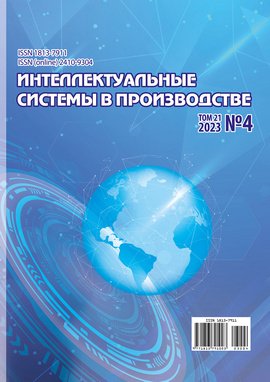Investigation of Automatic Cannon Barrel Shape Impact on Oscillatory and Temperature haracteristics
DOI:
https://doi.org/10.22213/2410-9304-2023-4-81-87Keywords:
numerical methods, ballistics, automatic cannon, thermal conductivity, barrel vibrations, optimizationAbstract
The paper studies the effect of stiffeners in cross-section on the vibrations, barrel cooling, and firing accuracy. A quasi-one-dimensional mathematical model of barrel thermal conductivity is presented, taking into account the shape of the outer surface by the shape coefficient calculated on the basis of the perimeter of the barrel outer surface with stiffeners. When modeling the firing of a burst from a 30-mm cannon, the problem of internal ballistics was solved in a thermodynamic formulation, taking into account the distribution of the parameters of the gas-powder mixture along the length of the barrel and back pressure; in the time intervals between shots, the problem of gas outflow from the barrel was solved. Longitudinal-transverse vibrations of the barrel were calculated using a quasi-one-dimensional mathematical model. Boundary-value problems were solved using the integral-interpolation method. Cauchy problems were solved by the Runge-Kutta method. The permissible thickness of the barrel when fired is calculated. The results of modeling for a barrel with stiffeners are presented. It is shown that the amplitude of vibrations of a barrel with stiffeners is 36% less than the amplitude of vibrations of a cylindrical barrel. The spread of points of destruction when shooting at a vertical target at a distance of 1.5 km is reduced by 67%. The temperature of the outer surface of the barrel for each of 10 shots is reduced by 25% and when firing a burst of 100 shots it is reduced by 16%.References
Самарский А. А., Гулин А. В. Численные методы. М.: Наука, 1989. 432 с.
Королев С. А., Липанов А. М., Русяк И. Г. К вопросу о точности решения прямой задачи внешней баллистики // Вестник Томского государственного университета: математика и механика. 2017. № 47. C. 63-74.
Дмитриевский А. А., Лысенко Л. Н. Внешняя баллистика: монография. М.: Машиностроение, 2005. 608 с.
Липанов А. М., Русяк И. Г., Суфиянов В. Г. Исследование влияния колебаний ствола на угол вылета снаряда при выстреле // Вестник Томского государственного университета: математика и механика. 2020. С. 80-94. DOI: 10.17223/19988621/68/8.
Русяк И. Г., Тененев В. А. Моделирование баллистики артиллерийского выстрела с учетом пространственного распределения параметров и противодавления // Компьютерные исследования и моделирование. 2020. С. 1123-1147. DOI: 10.20537/2076-7633-2020-12-5-1123-1147.
Михеев М. А., Михеева И. М., Основы теплопередачи. Изд. 2-е, стереотип. М.: Энергия, 1977. 344 с.
Самарский А. А., Вабищевич П. Н. Вычислительная теплопередача. М.: Едиториал УРСС, 2002. 784 с.
Клюкин Д. А. Математическое моделирование теплового нагружения ствола артиллерийского орудия при выстреле // Выставка инноваций - 2022 (весенняя сессия): Сборник материалов XXXIII Республиканской выставки-сессии студенческих инновационных проектов. Ижевск. 29 апреля 2022 года. Ижевск: Ижевский государственный технический университет имени М. Т. Калашникова. 2022. С. 176-182. DOI: 10.22213/ie022124.
Орлов Б. В., Ларман Э. К., Маликов В. Г. Устройство и проектирование стволов артиллерийских орудий. М.: Машиностроение, 1976. 432 с.
Mk44 Bushmaster II // Wikipedia. URL: https://en.wikipedia.org/wiki/Mk44_Bushmaster_II (дата обращения 06.07.2023).
UT30MK2 & MT30. Unmanned and Manned Turrets // Elbit Systems Ltd. URL: https://elbitsystems.com /media/UTMT-30-6pgs_3_PRINT.pdf (дата обращения 06.07.2023 г.).
Русяк И. Г., Суфиянов В. Г., Клюкин Д. А. Одномерная математическая модель колебаний ствола с поперечным сечением произвольной формы // Вестник Томского государственного университета. Математика и механика. 2022. № 80. С. 133-146. DOI: 10.17223/19988621/80/12.
Пушкарев А. М., Вольф И. Г., Ихтисанов И. И. Исследование теплового состояния стволов оружия и влияния его на начальную скорость снаряда // Известия Тульского государственного университета. Технические науки. 2020. № 11. С. 26-31.
Koniorczyk P., Zmywaczyk J., Debski A., Zielinski M., Preiskorn M., Sienkiewicz J. Investigation of Thermophysical Properties of Three Barrel Steels // Metals. 2020. 10, 573. DOI: 10.3390/met10050573.
Zieliński M., Koniorczyk P., Surma Z., Zmywaczyk J., Preiskorn M. Numerical Study of Heat Transfer in a Gun Barrel Made of Selected Steels // Energies. 2022. 15(5):1868. DOI: 10.3390/en15051868.
Mishra A., Hameed A., Lawton B. A Novel Scheme for Computing Gun Barrel Temperature History and Its Experimental Validation // ASME. J. Pressure Vessel Technol. 2010. 132(6): 061202. DOI: 10.1115/1.4001740.
Sopok S., Rickard C., Dunn S. Thermal-chemical-mechanical gun bore erosion of an advanced artillery system part one: theories and mechanisms // Wear. vol. 258. Issues 1-4. 2005. p 659-670. DOI: 10.1016/j.wear.2004.09.031.
Feng GT., Zhou KD., Zhang YQ., He L., Li JS., Wang J. The Study of Gun Barrel's Two-Dimensional Nonlinear Thermal Conduction // Int J Thermophys. 2019. 40(37) DOI: 10.1007/s10765-019-2502-8.
Downloads
Published
How to Cite
Issue
Section
License
Copyright (c) 2024 Иван Григорьевич Русяк, Вадим Гарайханович Суфиянов, Даниил Анатольевич Клюкин

This work is licensed under a Creative Commons Attribution 4.0 International License.


